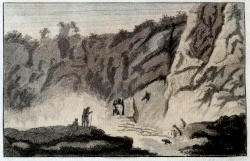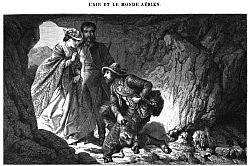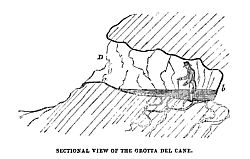Dog’s Caves




There are numerous caves named dog cave or dog’s cave because of a story or legend with a dog and the cave. Sometimes there were dead dogs found inside, sometimes a dog got lost and was saved, sometimes a dog saved someone lost inside the cave. That is not what we are talking about on this page.
A dog cave is a cave where a person entering the cave does not sense anything, while his accompanying dog collapses. The dog dies in a few minutes if it is not brought back, out of the cave. If it is brought back in time, the dog soon recovers and appears to be unharmed.
This effect was noted many years ago, and the most prominent spot is also the oldest known such cave:
 Grotta del Cane
in Italy, near Napoli.
It was described by Pliny the Elder in Roman times, Johann Wolfgang von Goethe and Andre Dumas.
While this disturbing effect was a source of fear in old ages, it became a tourist attraction during the 19th century, when people from northern Europe started modern tourism by travelling to Italy.
Today the dog caves are almost forgotten.
Grotta del Cane
in Italy, near Napoli.
It was described by Pliny the Elder in Roman times, Johann Wolfgang von Goethe and Andre Dumas.
While this disturbing effect was a source of fear in old ages, it became a tourist attraction during the 19th century, when people from northern Europe started modern tourism by travelling to Italy.
Today the dog caves are almost forgotten.
Now for the geologic background. Actually, a dog cave is not a cave type. In most cases, it is not even a cave. Typically, it is more or less artificial, a quarry or cellar. In areas with volcanism, the magma in the underground produces various gases, mainly carbon dioxide (CO2) and steam. The carbon dioxide often gets dissolved by groundwater, and when the water reaches the surface, it is called carbonated mineral water with this nice bubbling. If the carbon dioxide reaches the surface as a gas, it forms sources of carbon dioxide gas, which mostly go unnoticed, except if they bubble up from a lake floor or inside a confined space. In a confined space, there is no wind, so the carbon dioxide, which is heavier than normal air, forms a sort of gas lake at the floor of the cave.
And that is the reason for the effect on the dog: there is almost no oxygen on the floor, so the dog suffocates. But as carbon dioxide is not poisonous, the animal recovers as soon as it gets enough oxygen. People do not mention the gas, as they are too high. They would also get unconscious if they lied down.
Carbon dioxide is invisible, but it is possible to visualize the surface of the carbon dioxide lake with soap bubbles. The bubbles contain normal air, which is lighter than pure carbon dioxide, so the bubbles swim on the carbon dioxide lake.
The production of carbon dioxide by volcanism is really common, actually the gas is a good marker for increasing volcanic activity. But a steady production combined with a situation where the gas is not dispersed by wind, and thus a lake of carbon dioxide is formed, is quite rare. We know of five such places worldwide, all five are listed below.
 Grotte du Chien
Grotte du Chien Pamukkale
Pamukkale Cueva de la Muerte
Cueva de la Muerte Search DuckDuckGo for "Dog’s Caves"
Search DuckDuckGo for "Dog’s Caves" Cave of Dogs - Wikipedia (visited: 24-FEB-2011)
Cave of Dogs - Wikipedia (visited: 24-FEB-2011) Le DIOXYDE DE CARBONE un gaz qui est pesant... (visited: 24-FEB-2011) (
Le DIOXYDE DE CARBONE un gaz qui est pesant... (visited: 24-FEB-2011) ( )
)
 Index
Index Topics
Topics Hierarchical
Hierarchical Countries
Countries Maps
Maps